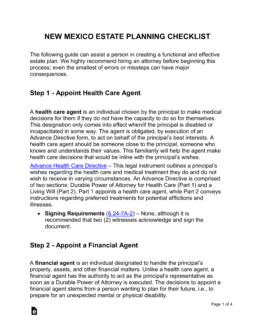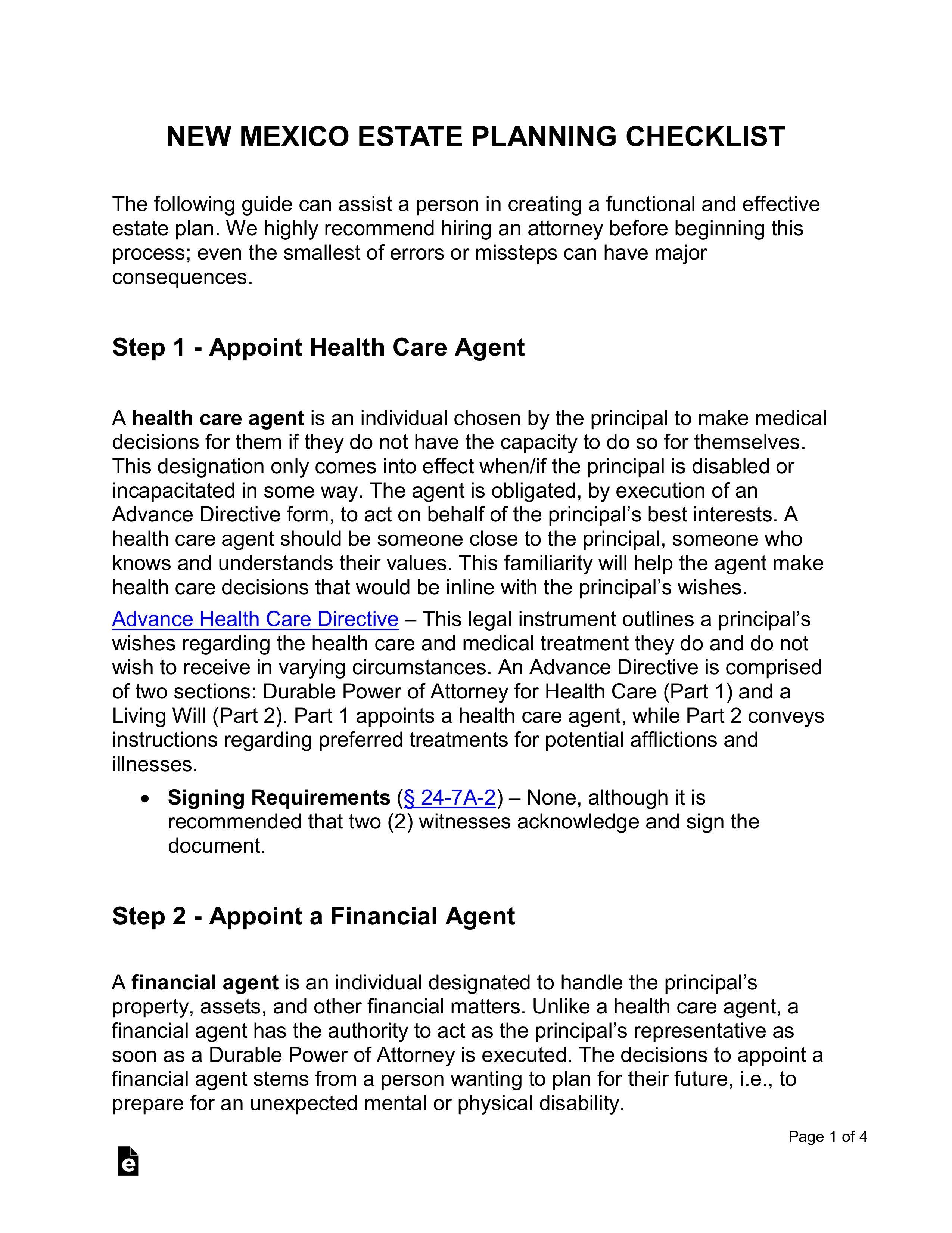Updated March 05, 2024
A New Mexico estate planning checklist is a form that lists all of the necessary steps to complete an estate plan. An estate owner, or principal as they shall be hereinafter referred to, creating an estate plan will be thinking about what will happen to them, their family, and their estate if they die or become incapacitated or disabled. The following documents will give the principal peace of mind knowing that all bases are covered in the event of an unfortunate accident or untimely death; an Advance Directive, a Durable (Financial) Power of Attorney, a Last Will and Testament, and a Revocable Living Trust. These estate planning tools cover medical decisions and health care (Advance Directive), financial decisions (Power of Attorney), estate distribution and family matters (Will), and general estate planning (Trust).
How to Create an Estate Plan in New Mexico (6 steps)
- Appoint Health Care Agent
- Appoint Financial Agent
- Make a List of Assets
- Choose Who Will Receive an Inheritance
- Execute a Will and/or a Living Trust
- Safely Store Documents
The following guide can assist a person in creating a functional and effective estate plan. We highly recommend hiring an attorney before beginning this process; even the smallest of errors or missteps can have major consequences.
1. Appoint Health Care Agent
A health care agent is an individual chosen by the principal to make medical decisions for them if they do not have the capacity to do so for themselves. This designation only comes into effect when/if the principal is disabled or incapacitated in some way. The agent is obligated, by execution of an Advance Directive form, to act on behalf of the principal’s best interests. A health care agent should be someone close to the principal, someone who knows and understands their values. This familiarity will help the agent make health care decisions that would be in line with the principal’s wishes.
Advance Health Care Directive – This legal instrument outlines a principal’s wishes regarding the health care and medical treatment they do and do not wish to receive in varying circumstances. An Advance Directive is comprised of two sections: Durable Power of Attorney for Health Care (Part 1) and a Living Will (Part 2). Part 1 appoints a health care agent, while Part 2 conveys instructions regarding preferred treatments for potential afflictions and illnesses.
- Signing Requirements – None, although it is recommended that two (2) witnesses acknowledge and sign the document.[1]
2. Appoint Financial Agent
A financial agent is an individual designated to handle the principal’s property, assets, and other financial matters. Unlike a health care agent, a financial agent has the authority to act as the principal’s representative as soon as a Durable Power of Attorney is executed. The decision to appoint a financial agent stems from a person wanting to plan for their future, i.e., to prepare for an unexpected mental or physical disability.
Durable (Financial) Power of Attorney – A Durable Power of Attorney appoints a financial agent to manage all (or a portion of) the principal’s assets, property, investments, and other financial matters pertaining to their estate. This is a very impactful document, and it should be executed with great care and consideration. The financial agent is awarded power of attorney as soon as the document is signed, and the power of attorney remains in full effect regardless of the principal’s state of mental and physical health.
- Signing Requirements – Must be acknowledged and signed by a notary public.[2]
Financial Powers Allowed:
- Real property[3]
- Tangible personal property[4]
- Stocks and bonds[5]
- Commodities and options[6]
- Banks and other financial institutions[7]
- Operation of entity or business[8]
- Insurance and annuities[9]
- Estates, trust and other beneficial interests[10]
- Claims and litigation[11]
- Personal and family maintenance[12]
- Benefits from governmental programs or civil or military service[13]
- Retirement plans[14]
- Taxes[15]
- Gifts[16]
3. Make a List of Assets
4. Choose Who Will Receive an Inheritance
5. Execute a Will and/or a Living Trust
There are two (2) documents most commonly used for conveying one’s wishes regarding the distribution of one’s estate after death. A Last Will and Testament and a Revocable Living Trust share a few characteristics, but ultimately they are very different instruments. While a Trust is a very useful estate planning tool, it is recommended that everyone create a Will to ensure that there is no room for interpretation when it comes time to handle the principal’s affairs after they die.
Last Will and Testament – A Will is a document executed by a principal, or “testator” as they are referred to, that contains directions for the distribution of their estate and all assets under their name after they die. An executor is named as the individual who will oversee the distribution process. As mentioned in Step 4, beneficiaries are to be named in the Will unto which property and other assets will be bestowed. A Will doesn’t just contain who gets what, it can also include instructions regarding debts and taxes, guardianship for children, and property management for children that are too young to handle such matters. After the testator’s death, a Will must go through probate court to ensure that the document was executed in accordance with State law.
- Signing Requirements – At least two (2) witnesses.[17]
(Revocable) Living Trust – A Revocable Living Trust becomes an entity into which property can be transferred once the appropriate documents have been executed. This is a very effective estate planning tool for protecting property, avoiding lengthy court proceedings, and maintaining privacy. These are benefits that would be especially appealing to those with large estates or those who anticipate disagreements between family members or challenges from third parties. To execute a Living Trust, the grantor (principal) must appoint a trustee, a successor trustee, and one (1) or more beneficiaries. A trustee (usually the grantor) manages the Trust, and the successor trustee takes over after the grantor’s death, providing the grantor is also the trustee. The named beneficiaries will receive the portion of the grantor’s estate that was allotted to them as per the instructions of the Trust document. A Revocable Living Trust can be amended at any time during grantor’s lifetime and will not have to go through probate after they die, therefore, it will remain out of public record.
- Signing Requirements – A Trust can be created only if the requirements are met.[18]
6. Safely Store Documents
New Mexico Estate Planning Laws
- Advance Health Care Directive – § 24-7A-2
- Uniform Power of Attorney – § 45-5B(101-123)
- Last Will and Testament – § 45-2(501-517)
- Revocable Living Trust – § 46A-6


